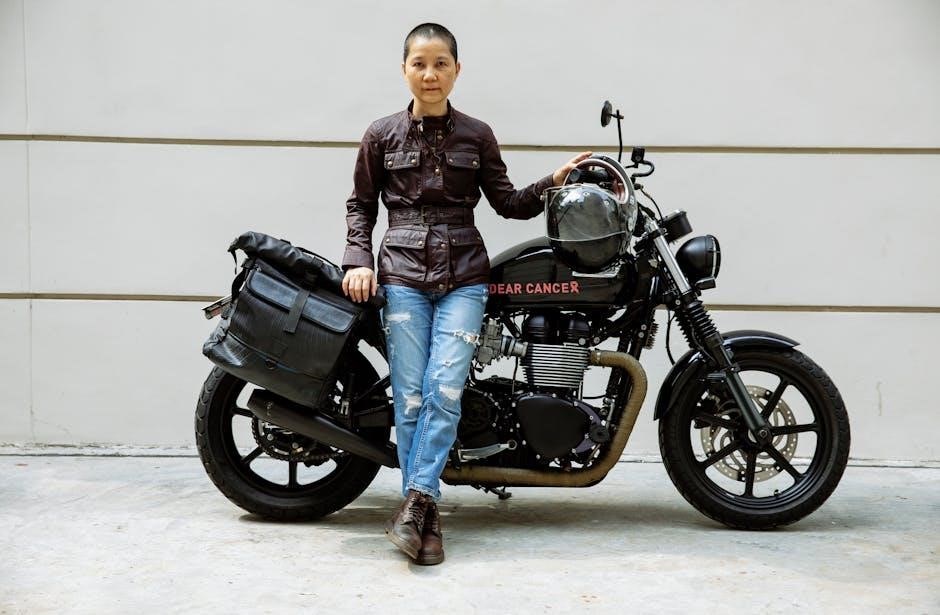A well-fitting motorcycle jacket ensures safety‚ comfort‚ and style. This guide helps riders choose the right size by understanding measurements‚ fit‚ and material-specific sizing for optimal protection and mobility.
1.1 Importance of Proper Fit in Motorcycle Jackets
A proper fit in motorcycle jackets is crucial for safety‚ comfort‚ and mobility. A well-fitted jacket ensures optimal protection by keeping armor in place during impact. It also prevents restrictive movement‚ allowing riders to control their bike effortlessly. Poor fit can lead to discomfort‚ distraction‚ or even safety hazards. Ensuring the right size is essential for both protection and performance‚ making it a critical factor in choosing the right motorcycle jacket.
1.2 Purpose of a Size Guide for Motorcycle Jackets
A size guide for motorcycle jackets serves as a tool to help riders select the perfect fit. It ensures the jacket provides optimal protection‚ comfort‚ and mobility. By offering standardized measurements‚ it helps riders understand their size across different brands and styles. The guide also accounts for variations in materials and designs‚ making it easier to choose a jacket that meets specific needs. Ultimately‚ it enhances the riding experience by ensuring safety‚ comfort‚ and style.

Types of Motorcycle Jackets
Motorcycle jackets vary by material and design‚ offering options for different riding styles. Leather jackets provide durability‚ textile jackets offer versatility‚ and mesh jackets enhance breathability for warm weather.
2.1 Leather Jackets
Leather jackets are a classic choice for motorcyclists‚ offering exceptional durability and abrasion resistance. Made from high-quality hides‚ they provide excellent protection in case of falls. Proper sizing is crucial‚ as leather molds to the body over time‚ ensuring a tailored fit. When measuring for a leather jacket‚ consider its thickness and flexibility. A well-fitted leather jacket not only enhances safety but also adds a stylish touch to any rider’s gear.
Always check the weight and finish of the leather to ensure it meets your riding needs.
2.2 Textile Jackets
Textile jackets are versatile and lightweight‚ ideal for riders seeking comfort in varying weather conditions. Made from materials like nylon or polyester‚ they often feature waterproof and breathable linings. These jackets are easy to move in‚ making them perfect for long rides. Sizing may vary slightly due to fabric flexibility‚ so ensure a snug fit without restricting movement. Textile jackets are a practical choice‚ balancing durability and comfort while offering excellent value for everyday riding adventures and seasonal layering needs.
2;3 Mesh Jackets
Mesh jackets are designed for hot weather‚ offering maximum ventilation and breathability. Made from lightweight‚ breathable materials like nylon or polyester mesh‚ they provide airflow‚ keeping riders cool. These jackets often feature built-in armor for impact protection‚ despite their lightweight design. Mesh jackets are ideal for warm climates and summer rides‚ combining comfort with essential safety features. Proper fit is crucial to ensure protection and mobility‚ making them a popular choice for riders prioritizing ventilation without compromising safety.

How to Measure Yourself for a Motorcycle Jacket
Accurate measurements ensure a proper fit. Measure chest‚ waist‚ sleeve length‚ and body length to match your size against the jacket’s size chart for optimal comfort and protection.
3.1 Measuring Chest Size
Measuring your chest size is crucial for a proper fit. Wrap a flexible tape measure around the widest part of your chest‚ keeping it level and parallel to the floor. Ensure the tape is snug but not tight‚ and avoid inhaling deeply as this may inflate your chest size temporarily. Note the measurement accurately‚ as this will be your primary reference for selecting the right jacket size; This ensures optimal comfort and protection while riding. Always double-check your measurement for accuracy.
3.2 Measuring Waist Size
To measure your waist size‚ locate your natural waistline‚ typically just above the belly button. Wrap a flexible tape measure around this area‚ ensuring it’s level and not too tight or loose. This measurement is crucial for determining the right jacket size‚ as it affects how the jacket fits around your midsection. A correct waist measurement ensures the jacket stays securely in place while riding‚ promoting both safety and comfort. Accurate measurement is key to choosing the best fit.
3.3 Measuring Sleeve Length
To measure sleeve length‚ stand upright with your arms relaxed by your sides. Place the tape measure at the center of your shoulder‚ just above the shoulder blade‚ and extend it down to your wrist. Ensure the tape is straight and not twisted. This measurement helps determine the ideal sleeve length for your motorcycle jacket‚ ensuring it fits comfortably while allowing full arm mobility. Proper sleeve length is essential for both comfort and safety during rides.
3.4 Measuring Body Length
Measuring body length involves determining the jacket’s length from the base of the neck to the desired hem. Stand tall and place the tape measure at the back of the neck‚ just below the collarbone. Run it straight down the torso to the point where you want the jacket to end‚ typically at the hip or lower. This ensures the jacket provides adequate coverage and comfort‚ especially for longer rides‚ while maintaining a stylish fit. Accurate body length is crucial for optimal protection and mobility.

Understanding Motorcycle Jacket Size Charts
Motorcycle jacket size charts provide standardized measurements for chest‚ waist‚ sleeve length‚ and body length. They vary by brand‚ material‚ and jacket type‚ ensuring a precise fit for optimal comfort and safety while riding. Referencing these charts helps riders select the correct size‚ considering factors like armor‚ layering‚ and seasonal use‚ ensuring both style and functionality.
4.1 Standard Size Charts
Standard size charts provide a consistent reference for measuring chest‚ waist‚ sleeve length‚ and body length. They typically range from Small to 4XL‚ catering to various body types. Charts may include numeric or alphanumeric sizing. Proper measurement techniques are crucial for accurate fit. Always consider brand-specific variations‚ as standard charts may differ. Referencing these charts ensures riders find jackets that offer both comfort and protection‚ enhancing the overall riding experience.
4.2 Size Variations Across Brands
Motorcycle jacket sizing differs significantly across brands due to design priorities and target audiences. Some brands focus on a slim‚ fashionable fit‚ while others emphasize comfort with a looser cut. European brands often offer slimmer profiles‚ contrasting with the more relaxed fits common in American brands. Materials also influence sizing‚ as leather and mesh jackets may fit differently. To navigate these variations‚ always consult brand-specific size charts and consider customer reviews for insights into fit accuracy and comfort.
4.3 How to Read a Size Chart
Reading a motorcycle jacket size chart involves matching your measurements to the chart’s numerical ranges. Start by identifying your chest‚ waist‚ and sleeve measurements. Compare these to the chart’s corresponding columns to find your size. Note that size labels (S‚ M‚ L) may vary‚ so rely on measurements rather than labels. Pay attention to fit descriptions like slim or relaxed to ensure the jacket meets your comfort needs. Double-check the chart for any specific brand annotations or fit adjustments.

Fit and Style Considerations
Choosing the right fit and style ensures comfort and functionality. Consider slim or regular fits‚ adjust for armor‚ and layer for seasonal needs to enhance your riding experience.
5.1 Slim Fit vs. Regular Fit
When choosing between slim and regular fits‚ consider your riding style and body type. Slim-fit jackets offer a tailored look and reduced wind resistance‚ ideal for sporty rides. Regular fits provide more comfort and flexibility‚ suitable for long-distance touring. Ensure proper mobility by testing both styles. Adjustments like zippers or stretch panels can enhance fit. Prioritize comfort without compromising protection for optimal performance on the road.
5.2 Adjusting for Armor and Pads
Motorcycle jackets with built-in armor or pads require careful sizing to ensure proper fit and protection. Armor can add bulk‚ so consider jackets with adjustable straps or zippers to customize the fit. Try the jacket with the armor in place to ensure mobility and comfort. Look for features like padded shoulders and elbows that can be adjusted. Check if the jacket allows for movement without restricting your arms or torso. Ensure the fit is snug but not tight‚ as this can compromise safety and comfort during rides.
5.3 Seasonal Jackets and Layering
Seasonal jackets vary in thickness and material‚ requiring adjustments in sizing. Summer jackets are lightweight‚ while winter styles may include insulation. Layering affects fit‚ as thermal or waterproof layers add bulk. Ensure the jacket fits comfortably over base layers without restricting movement. Consider adjustable features like zippered vents or removable liners for versatility. Proper sizing ensures safety and comfort‚ regardless of weather conditions. Always check how layering impacts mobility and protection before finalizing your size.

Material-Specific Sizing
Different materials like leather‚ textile‚ and mesh have unique sizing needs. Leather stretches over time‚ while textile and mesh jackets maintain consistent fits. Choose accordingly for optimal comfort.
6.1 Sizing for Leather Jackets
Leather jackets require precise sizing as they stretch with wear. Start by measuring your chest‚ waist‚ and sleeve length. Add 1-2 inches for a snug fit‚ as leather molds to your body over time. Consider weight variations—thicker leathers may need a slightly larger size; Always refer to brand-specific charts‚ as sizing can vary depending on the manufacturer. Proper fit ensures comfort and protection while riding.
6.2 Sizing for Textile and Mesh Jackets
Textile and mesh jackets offer flexibility in sizing due to their breathable‚ lightweight materials. Measure your chest‚ waist‚ and sleeve length as usual. Textile jackets may have a slightly looser fit‚ while mesh jackets often fit snugly for reduced wind flap. Consider adjustable cuffs and hem for customization. Lighter materials mean less need for size adjustments‚ but ensure mobility isn’t restricted. Brand-specific charts are essential‚ as sizing can vary based on fabric composition and design features.
6.3 How Material Weight Affects Fit
Material weight significantly impacts the fit of motorcycle jackets. Heavier materials‚ like thick leather‚ may require sizing up for comfort‚ while lighter textiles or mesh often fit closer to your body. Adjustments like cuffs and hem can help customize the fit. Ensure the jacket allows full mobility and doesn’t feel restrictive. Always check size charts for specific materials‚ as weight variations can affect how the jacket sits on your frame‚ balancing protection and comfort effectively.

Additional Features Affecting Fit
Features like pockets‚ armor‚ and adjustable cuffs can alter a jacket’s fit. Consider these elements when choosing your size to ensure both comfort and functionality on the road.
7.1 Pockets and Storage
Pockets and storage compartments in motorcycle jackets can add bulk‚ affecting fit. Measure with items like phones or gloves in mind to ensure comfort and accessibility while riding. Properly placed pockets should not restrict movement or cause tightness. Consider jackets with adjustable or expandable storage for better fit customization. Always check how these features impact your overall size choice to maintain both functionality and a comfortable riding experience.
7.2 Adjustable Cuffs and Hem
Adjustable cuffs and hem allow for a tailored fit‚ enhancing comfort and weather protection. These features ensure a secure fit without restricting movement. Velcro or zippered closures are common‚ offering easy adjustments. When measuring‚ consider how these elements affect sleeve length and body proportions. Proper adjustment ensures optimal fit‚ preventing drafts or bulkiness. Always test adjustments while wearing to guarantee a comfortable and functional fit for varying riding conditions and personal preference.
7.3 Impact Protection and Armor
Impact protection and armor are crucial for motorcycle jacket safety. Jackets often feature built-in pads or pockets for armor at the shoulders‚ elbows‚ and back. When sizing‚ ensure the armor fits snugly without causing discomfort. Proper placement ensures maximum protection. Consider jackets with removable armor for versatility. Always check for CE certification‚ indicating compliance with safety standards. A well-fitted jacket with appropriate armor enhances both safety and confidence while riding‚ making it essential to prioritize these features during the sizing process.

Trying on a Jacket
Trying on a jacket ensures proper fit and comfort. Check shoulder alignment‚ sleeve length‚ and mobility. Wear similar clothing for accuracy and assess armor placement.
8.1 Tips for In-Person Fittings
When trying on a jacket in person‚ wear similar clothing to what you’d ride in. Sit on a bike or mimic riding posture to ensure mobility. Check shoulder fit‚ sleeve length‚ and chest alignment. Move arms to verify freedom of movement. Ensure armor or padding sits correctly. If possible‚ compare sizes and styles to find the best fit. Don’t hesitate to ask for sizing recommendations from store staff for a personalized experience.
8.2 Online Shopping Considerations
When shopping online‚ always check the size chart specific to the brand and model. Read reviews from other riders to gain insights into fit and comfort. Compare your measurements with the chart‚ paying attention to chest‚ sleeve length‚ and body length. Consider adjustable features like cuffs and hem for a tailored fit. Look for high-quality images and detailed descriptions to assess material and construction. Finally‚ check return and exchange policies to ensure flexibility if the fit isn’t perfect.

Common Fit Issues and Solutions
Common fit issues include jackets being too tight or loose‚ affecting mobility and comfort. Solutions involve adjusting sizes‚ tailoring‚ or using adjustable features like cuffs and hem for a better fit.
9.1 Jacket Too Tight or Too Loose
A jacket that is too tight restricts movement‚ while one too loose may compromise protection. Ensure proper fit by measuring accurately and considering layering or adjustable features. Solutions include resizing or tailoring to achieve optimal comfort and safety while riding. Proper fit ensures better mobility and protection‚ making it essential for a safe and enjoyable riding experience. Always check size charts and reviews to avoid fit issues before purchasing.
9.2 Sleeve Length Adjustments
Proper sleeve length ensures comfort and protection while riding. Sleeves should cover wrists fully when arms are extended. If too short‚ mobility is limited; if too long‚ they may interfere with gloves. Adjustable cuffs or hem adjustments can help achieve the perfect fit. Ensure sleeves align with gloves for seamless protection. Correcting sleeve length ensures better control and safety‚ enhancing overall riding performance and comfort on the road.
9.3 Body Length and Mobility
Body length and mobility are crucial for comfort and protection. The jacket should fit snugly‚ covering the torso without restricting movement. A jacket that’s too short may ride up while riding‚ while one that’s too long can hinder mobility. Ensure the length aligns with your riding posture to maintain full coverage and ease of movement. Adjustable hems and flexible materials can enhance fit and mobility‚ ensuring optimal comfort and safety while on the road.

Brand-Specific Sizing
Motorcycle jacket sizing varies by brand‚ with each having its own fit profile. Always check specific measurements‚ as sizes can differ even if you know the brand well.
10.1 Popular Brands and Their Fit Profiles
Popular motorcycle jacket brands like Harley-Davidson‚ Alpinestars‚ and Dainese offer distinct fit profiles. Harley-Davidson often features a classic‚ relaxed fit‚ while Alpinestars and Dainese cater to sporty‚ slim builds. Schott NYC is known for a vintage‚ tailored look. Each brand tailors its sizing to specific riding styles‚ so it’s essential to check their size charts. Understanding these differences helps riders choose jackets that align with their body type and preferences for optimal comfort and performance.
10.2 How to Check Brand-Specific Measurements
To ensure accuracy‚ always consult the brand’s official size chart‚ usually found on their website or product pages. Compare your measurements with their chart‚ focusing on chest‚ waist‚ sleeve length‚ and body length. Some brands provide detailed sizing guides or videos for better accuracy. Double-checking your measurements with theirs ensures a proper fit. If unsure‚ consider trying the jacket on or referring to customer reviews for insights into how the brand’s sizes run;
A well-fitting motorcycle jacket is crucial for safety‚ comfort‚ and style. Use this guide to find your perfect size and enjoy a secure‚ enjoyable ride always.
11.1 Final Tips for Choosing the Right Size
Always consult the size chart and measure carefully. Consider material stretch and armor fit. Check adjustable cuffs and hem for customization. Read reviews for brand-specific sizing insights. If possible‚ try jackets in person or use online fit tools. Prioritize comfort and mobility without compromising protection. Ensure proper chest‚ sleeve‚ and body length alignment for optimal safety and style. A perfect fit enhances both performance and confidence on the road‚ making every ride enjoyable and secure.
11.2 Importance of Proper Fit for Safety and Comfort
A well-fitting motorcycle jacket is crucial for both safety and comfort. It ensures that protective features like armor stay in place‚ reducing injury risk. Proper fit enhances mobility‚ allowing better control of the bike‚ and prevents discomfort during long rides. A jacket that’s too tight may restrict movement‚ while one too loose might not provide adequate protection. Prioritizing fit ensures optimal safety‚ comfort‚ and confidence‚ making every ride more enjoyable and secure. A good fit is essential for a better riding experience.

No Responses